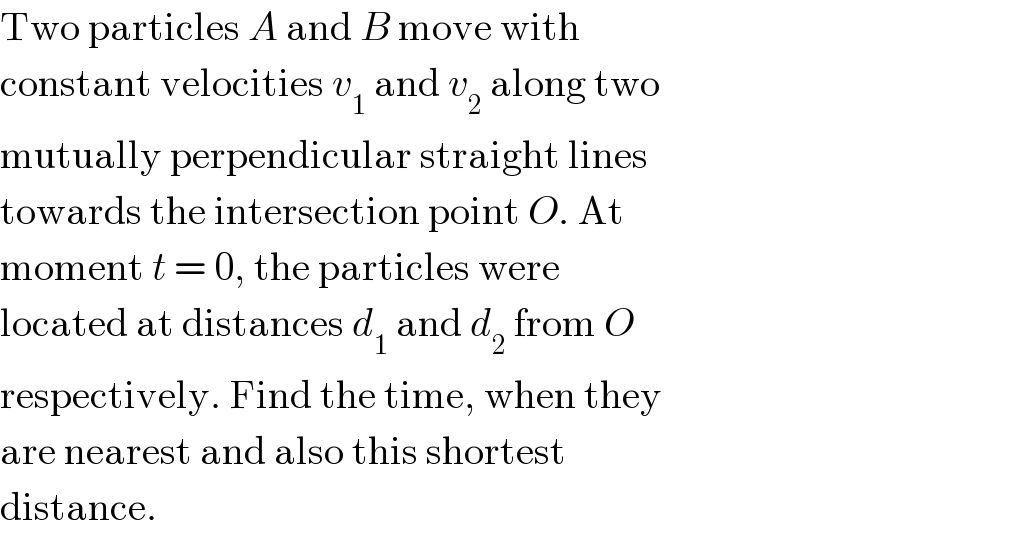
Question Number 19167 by Tinkutara last updated on 06/Aug/17

$$\mathrm{Two}\:\mathrm{particles}\:{A}\:\mathrm{and}\:{B}\:\mathrm{move}\:\mathrm{with} \\ $$$$\mathrm{constant}\:\mathrm{velocities}\:{v}_{\mathrm{1}} \:\mathrm{and}\:{v}_{\mathrm{2}} \:\mathrm{along}\:\mathrm{two} \\ $$$$\mathrm{mutually}\:\mathrm{perpendicular}\:\mathrm{straight}\:\mathrm{lines} \\ $$$$\mathrm{towards}\:\mathrm{the}\:\mathrm{intersection}\:\mathrm{point}\:{O}.\:\mathrm{At} \\ $$$$\mathrm{moment}\:{t}\:=\:\mathrm{0},\:\mathrm{the}\:\mathrm{particles}\:\mathrm{were} \\ $$$$\mathrm{located}\:\mathrm{at}\:\mathrm{distances}\:{d}_{\mathrm{1}} \:\mathrm{and}\:{d}_{\mathrm{2}} \:\mathrm{from}\:{O} \\ $$$$\mathrm{respectively}.\:\mathrm{Find}\:\mathrm{the}\:\mathrm{time},\:\mathrm{when}\:\mathrm{they} \\ $$$$\mathrm{are}\:\mathrm{nearest}\:\mathrm{and}\:\mathrm{also}\:\mathrm{this}\:\mathrm{shortest} \\ $$$$\mathrm{distance}. \\ $$
Commented by Tinkutara last updated on 06/Aug/17

Answered by ajfour last updated on 06/Aug/17

Commented by ajfour last updated on 06/Aug/17
![v_(relative) =v_r =(√(v_1 ^2 +v_2 ^2 )) AB=r=(√(d_1 ^2 +d_2 ^2 )) α=(α+θ)−θ rsin α=rsin (α+θ)cos θ−rcos (α+θ)sin θ =d_1 ((v_2 /v_r ))−d_2 ((v_1 /v_r )) .....(i) rcos α=rcos (α+θ)cos θ+sin (α+θ)sin θ =d_2 ((v_2 /v_r ))+d_1 ((v_1 /v_r )) .....(ii) From figure, shortest distance s is given by s=∣rsin α∣ =((∣d_1 v_2 −d_2 v_1 ∣)/(√(v_2 ^2 +v_1 ^2 ))) [see (i)] let time when at shortest distance be t_s , v_r t_s =rcos α t_s =((rcos α)/v_r ) =((d_1 v_1 +d_2 v_2 )/v_r ^2 ) [see (ii)] t_s =((v_1 d_1 +v_2 d_2 )/(v_1 ^2 +v_2 ^2 )) .](Q19177.png)
$$\mathrm{v}_{\mathrm{relative}} =\mathrm{v}_{\mathrm{r}} =\sqrt{\mathrm{v}_{\mathrm{1}} ^{\mathrm{2}} +\mathrm{v}_{\mathrm{2}} ^{\mathrm{2}} }\: \\ $$$$\mathrm{AB}=\mathrm{r}=\sqrt{\mathrm{d}_{\mathrm{1}} ^{\mathrm{2}} +\mathrm{d}_{\mathrm{2}} ^{\mathrm{2}} }\: \\ $$$$\alpha=\left(\alpha+\theta\right)−\theta \\ $$$$\mathrm{rsin}\:\alpha=\mathrm{rsin}\:\left(\alpha+\theta\right)\mathrm{cos}\:\theta−\mathrm{rcos}\:\left(\alpha+\theta\right)\mathrm{sin}\:\theta \\ $$$$\:\:\:\:\:\:\:\:\:\:=\mathrm{d}_{\mathrm{1}} \left(\frac{\mathrm{v}_{\mathrm{2}} }{\mathrm{v}_{\mathrm{r}} }\right)−\mathrm{d}_{\mathrm{2}} \left(\frac{\mathrm{v}_{\mathrm{1}} }{\mathrm{v}_{\mathrm{r}} }\right)\:\:\:\:.....\left(\mathrm{i}\right) \\ $$$$\mathrm{rcos}\:\alpha=\mathrm{rcos}\:\left(\alpha+\theta\right)\mathrm{cos}\:\theta+\mathrm{sin}\:\left(\alpha+\theta\right)\mathrm{sin}\:\theta \\ $$$$\:\:\:\:\:\:\:\:\:\:=\mathrm{d}_{\mathrm{2}} \left(\frac{\mathrm{v}_{\mathrm{2}} }{\mathrm{v}_{\mathrm{r}} }\right)+\mathrm{d}_{\mathrm{1}} \left(\frac{\mathrm{v}_{\mathrm{1}} }{\mathrm{v}_{\mathrm{r}} }\right)\:\:\:.....\left(\mathrm{ii}\right) \\ $$$$\:\:\:\:\:\mathrm{From}\:\mathrm{figure}, \\ $$$$\mathrm{shortest}\:\mathrm{distance}\:\mathrm{s}\:\mathrm{is}\:\mathrm{given}\:\mathrm{by} \\ $$$$\:\:\:\:\mathrm{s}=\mid\mathrm{rsin}\:\alpha\mid \\ $$$$\:\:\:\:\:\:=\frac{\mid\mathrm{d}_{\mathrm{1}} \mathrm{v}_{\mathrm{2}} −\mathrm{d}_{\mathrm{2}} \mathrm{v}_{\mathrm{1}} \mid}{\sqrt{\mathrm{v}_{\mathrm{2}} ^{\mathrm{2}} +\mathrm{v}_{\mathrm{1}} ^{\mathrm{2}} }}\:\:\:\:\:\:\:\:\:\:\:\:\left[\mathrm{see}\:\left(\mathrm{i}\right)\right] \\ $$$$\mathrm{let}\:\mathrm{time}\:\mathrm{when}\:\mathrm{at}\:\mathrm{shortest}\:\mathrm{distance} \\ $$$$\mathrm{be}\:\mathrm{t}_{\mathrm{s}} , \\ $$$$\:\:\mathrm{v}_{\mathrm{r}} \mathrm{t}_{\mathrm{s}} =\mathrm{rcos}\:\alpha \\ $$$$\:\:\:\:\mathrm{t}_{\mathrm{s}} =\frac{\mathrm{rcos}\:\alpha}{\mathrm{v}_{\mathrm{r}} }\:=\frac{\mathrm{d}_{\mathrm{1}} \mathrm{v}_{\mathrm{1}} +\mathrm{d}_{\mathrm{2}} \mathrm{v}_{\mathrm{2}} }{\mathrm{v}_{\mathrm{r}} ^{\mathrm{2}} }\:\:\:\:\:\left[\mathrm{see}\:\left(\mathrm{ii}\right)\right] \\ $$$$\:\:\:\:\:\:\:\:\:\:\:\mathrm{t}_{\mathrm{s}} \:=\frac{\mathrm{v}_{\mathrm{1}} \mathrm{d}_{\mathrm{1}} +\mathrm{v}_{\mathrm{2}} \mathrm{d}_{\mathrm{2}} }{\mathrm{v}_{\mathrm{1}} ^{\mathrm{2}} +\mathrm{v}_{\mathrm{2}} ^{\mathrm{2}} }\:. \\ $$
Commented by Tinkutara last updated on 06/Aug/17

$$\mathrm{Thank}\:\mathrm{you}\:\mathrm{very}\:\mathrm{much}\:\mathrm{Sir}! \\ $$
